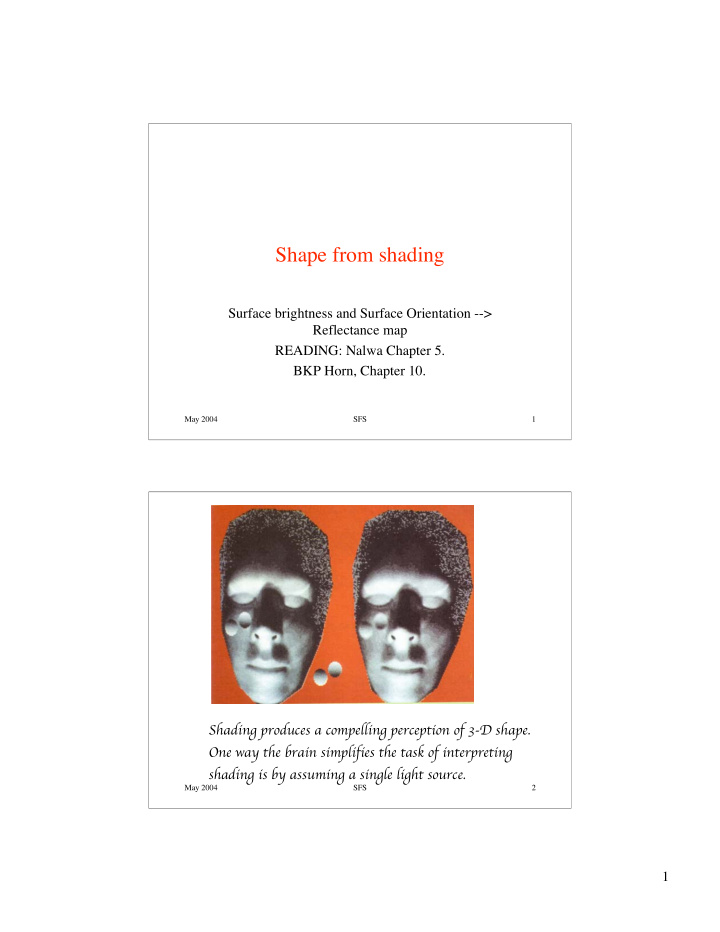



Shape from shading Surface brightness and Surface Orientation --> Reflectance map READING: Nalwa Chapter 5. BKP Horn, Chapter 10. May 2004 SFS 1 Shading produces a compelling perception of 3-D shape. One way the brain simplifies the task of interpreting shading is by assuming a single light source. May 2004 SFS 2 1
Shading as a cue to surface shape May 2004 SFS 3 Boundaries influence the interpretation of shaded surfaces May 2004 SFS 4 2
..and perceptual grouping of elementary features May 2004 SFS 5 helps to segregate the Dalmatian. Gradient Space • Orientation of a vector in 3-D space has two degrees of freedom. • Suppose we are interested in representing all vectors in a particular hemisphere, say z < 0 hemisphere: – We can then represent any such vector with a negative z component as (p, q). See next slide. May 2004 SFS 6 3
Gradient space May 2004 SFS 7 Gradient Space Let the imaged surface be Then its surface normal can be obtained as a cross product of the two surface vectors: Surface normal: May 2004 SFS 8 4
Reflectance Map • Reflectance map captures the dependence of brightness on surface orientation. • At a particular point in the image, we measure the image irradiance E(x,y). • This irradiance is proportional to the radiance at the corresponding point on the surface imaged. • If the surface gradient at that point is ( p,q ), then the radiance there is R( p,q ). – This assumes or ignores other contributing factors such as reflectance properties of the surface or distribution of light sources • Normalizing the proportionality constant, we get: E( x,y ) = R( p,q ) Image irradiance equation May 2004 SFS 9 Reflectance Map • I(x,y) = R (p(x,y), q(x,y)) • Both sides of the equation are normalized to have a maximum value of 1. • The reflectance map provides a normalized intensity for each surface orientation (p, q). • Many to one mapping: several different surface orientations may map to the same image intensity. – Each image intensity value only constrains the corresponding surface normal to some isobrightness contour in gradient space. – R(p,q) encodes both the light source distribution and the surface reflectance characteristics. – However, it is independent of the way in which the imaged surfaces are configured. May 2004 SFS 10 5
Incident and emittance angles May 2004 SFS 11 Lambertian surface Lambertian surface: appears equally bright from all viewing angles. Let the incident light direction be May 2004 SFS 12 6
Reflectance Map • Illuminant direction: - [1 0.5 -1] • Isobrightness contours of a reflectance map of a Lambertian surface are a set of conic sections in gradient space. May 2004 SFS 13 • Illuminated in the direction [1 0.5 -1] (from behind). • Note that the reflectance is minimum (i.e., 0) when -> when the angle between the direction from which the scene is lit and the surface normal is greater than 90 deg. -> A straight line in gradient space separates the shadowed regions from illuminated regions --this line is called the terminator. May 2004 SFS 14 7
Scene lit from -[0 0 -1]. Note that R(p, q) =1 only when May 2004 SFS 15 Another Example • Consider a surface that emits radiation equally in all directions (not physically possible). – Such a surface appears brighter when viewed obliquely, since the same power comes from a foreshortened area. – Brightness now depends on the inverse of the cosine of emittance angle. – Taking into account the foreshortened area as seen from the source, the radiance is proportional to: May 2004 SFS 16 8
q p Contours of constant brightness are parallel staright lines in gradient space May 2004 SFS 17 Why full moon appears flat? • The material in the maria of the moon can be modeled reasonably well by a function of • For such a surface: For (p_s, q_s) = (0,0) , we would obtain a uniformly bright disk in the image. • • Same conclusion if we start with the ratio with the two angles being equal. • Such a sphere, illuminated from a position near that of the viewer, appears flat to someone used to objects that are “Lambertian” like; – That is why full moon looks like a flat disk marked with blotches, The blothces are brightness variations due to differences in the surface’s reflecting efficiency. May 2004 SFS 18 9
Photometric Stereo • Two images, taken with different lighting, will yield two equations for each image point. • If these equations are linear and independent, there will be a unique solution for p and q. • For best results, the two light source directions should be far apart in gradient space. • For Lambertian surfaces, these lead to non-linear equations; there can be two solutions, one solution, or none, depending on the particular values of the intensity. May 2004 SFS 19 SFS: Shape determination • Characteristic Strip method [Section 5.1.3, Nalwa] • Given a point in the image and its counterpart in the reflectance map, an infinetisimal step in the image plane in the direction of the gradient of the reflectance map corresponds to an infinetismal step in gradient space in the direction of the gradient of the image irradiance. q y x p May 2004 SFS 20 10
SFS: end • Read the handout. • SFS, in general, provides a “qualitative” depth map • Reconstruction techniques, in general, are not very robust. • Applications: to estimating illuminant direction (Chellappa et al.), image registration (Zheng), image restoration (photocopying of books), etc… May 2004 SFS 21 11
Recommend
More recommend